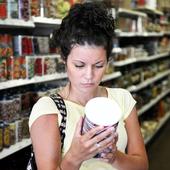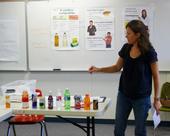- Author: Alec Rosenberg

The iconic black-and-white Nutrition Facts label for packaged foods in the U.S. is getting its first makeover in two decades. The federal government's decision last month to update the food label means that for the first time, beginning in 2018, labels will list how much added sugar is in a product.
The decision, reflecting the latest science, will be felt well beyond the label. University of California food experts praised the labeling changes and offered six key takeaways.
1. Listing added sugar is the most important label change.
The new label will list the amount of added sugar in a product, both in grams and as a percentage of the daily recommended allowance.
“That's...
- Author: Jeannette E. Warnert

At the 8th Biennial Childhood Obesity Conference last week, UC President Janet Napolitano spoke about UC's Global Food Initiative (GFI), which aims to “to put the world on a pathway to feed itself in ways that are nutritious and sustainable.”
It was the first time a UC president has taken part in the long-running and nationally recognized gathering, noted the director of UC Agriculture and Natural Resources' Nutrition Policy Institute (NPI), Lorrene Ritchie.
“I think it demonstrates her commitment to the Global Food Initiative and the work we do at UC ANR,” Ritchie...
- Author: Jeannette E. Warnert

Manufacturers of soda alternatives - like Gatorade, Vitamin Water and Snapple teas - are promoting misleading claims to entice health conscious consumers to buy their products, according to a report released today by the Atkins Center for Weight and Health at UC Berkeley.
Researchers investigated the growing and often confusing list of supplements added to the drinks. In most cases, they found, the beverages provide little or no health benefits, and might be dangerous.
"Despite the positive connotation surrounding energy and sports drinks, these products are essentially sodas without the carbonation," said Patricia Crawford, UC...
- Author: Kim Girard

It's a drizzly winter morning, and dozens of volunteers at the San Francisco–Marin Food Bank are slowly breaking down a 2,000-pound sack of whole oats into 1-pound bags, their hair tucked back in neat plastic caps. A decade ago, volunteers were more likely to be boxing up canned foods items. Today, 60 percent of everything ferried out of this warehouse is fresh produce. No soda or chips are in sight, and whole grains like these General Mills oats are standard.
For food banks nationwide to move in a similar healthy direction, coordinated efforts must increase at all levels. It will take leadership like that provided by Feeding America, the national food bank network organization; expanded support for nutrition...
- Author: Ann Brody Guy

I recently switched from a small group practice to Kaiser when the rates for my old healthcare plan went up. My first visit to my new doctor was like something out of a happy-healthcare utopia: a farmer’s market out front hawked fresh peaches and plums; bright light streamed through tall windows as I found my way to a well-marked suite; a receptionist cheerily informed me there was no copay for this welcome visit.
But in my brief stay in the waiting room, I noticed there was an entire row of oversized chairs. And when I was ushered to the scale, in place of the typical stand with little black weights I found what can only be described as a freight scale — a large electronic platform at least 3 feet x 3 feet, built right into the...



